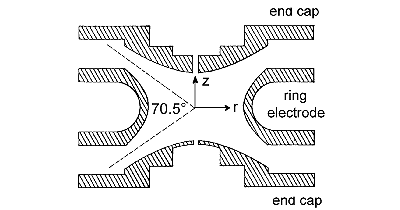a) Briefly describe the setup of a quadrupole ion trap.
The quadrupole ion trap (QIT) consists of two hyperbolic electrodes serving as end caps and a ring electrode that replaces two of the linear quadrupole rods, i.e., it could theoretically be obtained by rotating a linear quadrupole with hyperbolic rods through 360°. Thus, a section through the rz-plane of the QIT closely resembles that of the entrance of linear quadrupole with hyperbolic rods. A linear quadrupole mass analyzer consists of four hyperbolically or cyclindrically shaped rod electrodes extending in the z-direction and mounted in a square configuration (xy-plane). The pairs of opposite rods are each held at the same potential which is composed of a DC voltage U and a radiofrequency (RF) voltage V with the frequency f.

b) Give a short explanation of the working principle of a quadrupole ion trap.
The end caps are electrically connected and the DC and RF potentials are applied between them and the ring electrode. The working principle of the QIT is based on creating stable trajectories for ions of a certain m/z or m/z range while removing unwanted ions by colliding them with the walls or by axial ejection from the trap due to their unstable trajectories.